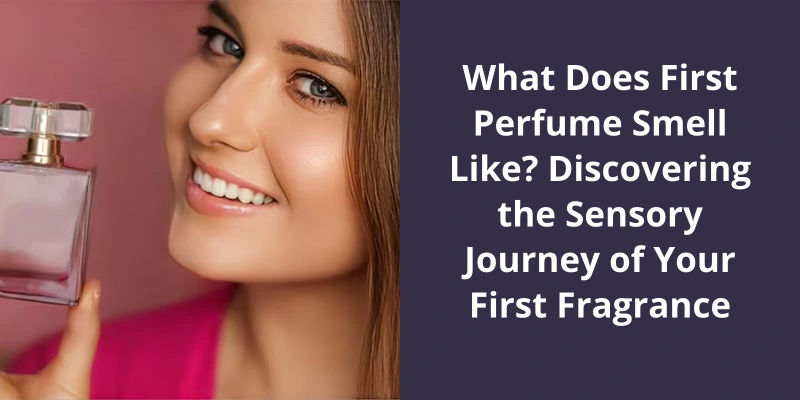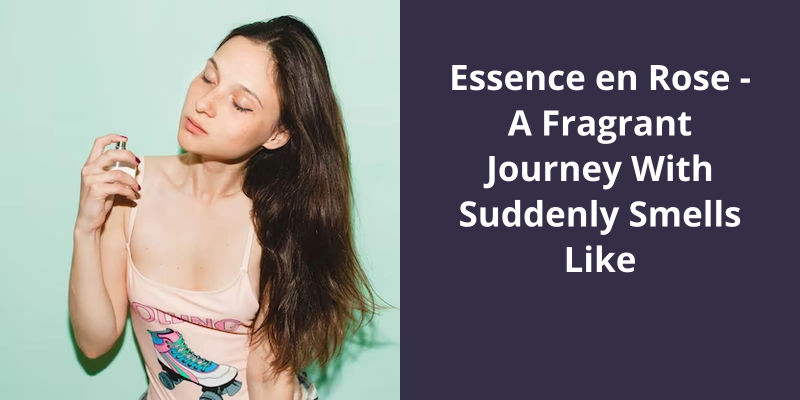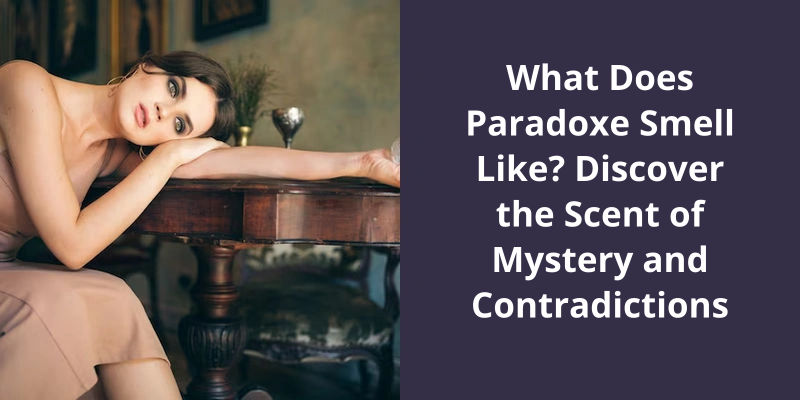Perfumes have been an integral part of human civilization since ancient times. There’s something enchanting and captivating about the fragrance that leaves a lasting impression on one's memory. The world of fragrances is diverse and encompasses a plethora of scents, each with it’s unique blend of ingredients and notes. One such perfume that’s stood the test of time and continues to entice fragrance enthusiasts is the First perfume. Designed by French perfumer Jean-Claude Ellena, First is an exquisite scent that exudes elegance and sophistication. The perfume's aroma is centered around jasmine, known for it’s sweet fragrance and delicate floral notes. Besides jasmine, the perfume also contains aldehydes and blackcurrant bud, adding further depth and richness to the scent. When you wear First, you’re transported to a world of opulence and luxury, where all your senses are heightened, and you feel as though you’re enveloped in a blanket of warmth and comfort. So, what does First perfume smell like? Read on to find out more.

What Was the First Modern Perfume?
Hungary Water has a fascinating history. According to legend, Queen Elizabeth of Hungary was suffering from illness and asked for a solution to alleviate her pain. A monk made a mixture of herbs and alcohol and gave it to her, which helped her regain her health. The queen was so grateful that she shared the recipe with the world, and thus the first modern perfume was born.
Over the centuries, Hungary Water became famous as a cure-all for various ailments. It was believed to have antiseptic qualities and was used to treat headaches, rheumatism, and even the plague. People also used it as a cosmetic, applying it to their skin and hair to improve their appearance.
As Hungary Water became more popular, other perfumes followed suit. French perfumers in particular began experimenting with essential oils and developed new fragrances that became popular amongst the rich and famous. Perfume became a symbol of luxury and glamour, with famous designers like Chanel and Dior creating their own signature scents that are still popular to this day.
Today, perfume is a multi-billion dollar industry, with countless brands and fragrances available to suit every taste and budget. Modern perfumes are complex blends of essential oils, alcohols, and synthetic compounds that are developed by skilled perfumers using advanced techniques.
It was the first modern perfume and paved the way for the many fragrances that came after it. It’s unique blend of herbs and spices continues to inspire perfumers today, and many people still enjoy using it for it’s healing and cosmetic properties.
Perfumes have been a cherished part of human history, with the oldest known perfume dating back to 4000 years. The discovery of a well-preserved fragrant substance in Cyprus provides a glimpse into the ingredients used in the first-ever perfume. The mixture contained extracts of lavender, rosemary, pine resin, and coriander. Let’s delve deeper into the fascinating history of perfume making.
What Are the Ingredients of the First Perfume?
Perfumes have been around since ancient times, but the ingredients used in the first perfumes were quite different from what we use today. The ancient Egyptians were the first to create perfumes, and they used a variety of natural ingredients like flower petals, cedarwood, myrrh, frankincense, and spices. They were used for religious purposes, as well as for personal adornment.
However, it was the Greeks who first started to use perfumes for cosmetic purposes. They created different scents for different occasions and seasons, and these perfumes were made from oils, resins, and plant extracts. They were popular among the wealthy, who’d mix their own perfumes to create their signature scent. The Romans also used perfumes, but they preferred more musky and animalistic scents.
As for the first perfume, the oldest recorded perfume in history was discovered in Cyprus in 200The perfume bottle dating back to 2,000 BC was found in a tomb dating back to the Bronze Age. The flask contained a well-preserved fragrant substance, which was analyzed to be a mixture of lavender, rosemary, pine resin, and coriander extracts. This showed that even thousands of years ago people had a sense of beauty and wanted to smell good.
It’s interesting to note that the art of perfumery was not limited to Europe and the Mediterranean. The ancient Chinese also had a tradition of making perfumes from natural ingredients. They used flower petals, herbs, and tree bark to create their fragrances. Perfumes were considered a luxury, and only the wealthy could afford them.
Over time, perfumes became more sophisticated, and new ingredients were added to create different scents. Synthetic perfumes were invented in the late 19th century, which allowed for more complex perfumes to be created. Today, perfumes are made from a variety of ingredients, both natural and synthetic, and are used by people all over the world to smell good and feel confident. The first perfume may have been simple, but it paved the way for the complex and beautiful fragrances we’ve today.
Source: What were perfumes made from in the past? The ingredients …
Throughout history, perfume has held a significant place in many cultures worldwide. From ancient Egypt to modern-day France, perfume has been highly regarded for it’s ability to evoke emotions, memories, and even allure. Let’s dive deeper to know about the popularization of perfume among the people of different cultures.
Who Popularized Perfume?
These perfumes were made of lavender, bay, rosemary, pine, coriander, and thyme, all blended with alcohol and water. Interestingly, the ancient Egyptians believed that their perfumes had magical properties and could ward off evil spirits. They used perfumes in daily life and religious rituals. The Egyptians also developed a method of extracting perfume oils from flowers by soaking them in oil and letting them ferment.
During the Middle Ages, perfumes popularity declined in Europe due to the influence of the Christian church, which frowned upon extravagance and luxury. However, the trade in perfumes continued in the Islamic world, where it was used for medicinal purposes, as well as in personal hygiene and in religious ceremonies. The Crusaders brought back knowledge of perfume making to Europe, and it slowly regained popularity in the Renaissance. The Italians were the main proponents of perfume in Europe, and they developed a variety of scents such as neroli, bergamot, and rose.
In the 18th century, French perfumers became the world leaders in perfume making. The French king Louis XV appointed a perfumer to his court, and luxury perfumes became fashionable. The French perfume industry received a boost when Napoleon Bonapartes wife, Empress Josephine, encouraged the development of the perfume industry with her patronage. She’d a collection of over 160 different perfumes, and she used perfume as a political and diplomatic tool, giving gifts of perfume to foreign dignitaries.
During the 19th century, the rise of the middle class and the development of new technologies such as the steam engine and chemical synthesis, led to the mass production of perfumes. This made perfume more affordable and accessible to the public. Companies such as Guerlain and Houbigant pioneered the creation of new scents, and they marketed their perfumes to women. Coco Chanels creation of Chanel No. 5 in the 1920s, which utilized synthetic components, was a turning point in perfume history, as it marked the first time that perfumes were created using laboratory techniques.
In the modern era, perfume has become a multi-billion dollar industry with hundreds of different perfumes available on the market. Celebrities such as Jennifer Lopez, Britney Spears, and Beyoncé have all released their own line of perfumes. Perfume has also been used as a form of branding, with luxury fashion brands such as Chanel, Dior, and Yves Saint Laurent all having their own signature scents. Perfume continues to be used for personal hygiene and seduction, as well as in many other areas of life such as aromatherapy, home fragrance, and as a decorative object.
How to Choose and Wear Perfume as Part of Personal Style.
- Identify your personal preference for fragrance families: floral, oriental, woody, citrus, or fresh
- Consider the occasion and the time of day when choosing a fragrance
- Test perfumes on your skin to see how they interact with your body chemistry
- Avoid applying too much perfume, especially in public spaces
- Apply perfume to pulse points – wrists, neck, and behind the ears
- Consider layering fragrances for a unique scent
- Properly store perfumes in a cool, dry place away from direct sunlight
As America began to develop it’s own fragrance industry, companies like Guerlain and Elizabeth Arden began to create their own scents tailored to American tastes. However, the influence of French fragrances on American perfumery can still be seen today. From the earliest days of colonization to the present day, fragrance has played an important role in American culture.
What Was the First Scent?
With the French explorers came a new influx of fragrances with scents like lavender, bergamot, and violet becoming widely popular among the colonized communities. These fragrances symbolized the status and sophistication of the French people in the eyes of the American settlers. Pioneering perfumers such as Jean Louis Fargeon even opened up shops in America in the late 18th century.
As time progressed, American fragrances diversified, with fragrances such as bay rum becoming widely popular in the 19th century. This allowed for the development of a distinct American scent – one with a combination of classic French scents and the tropical flavors of the Caribbean.
The Industrial Revolution allowed for the mass production of fragrances, and by the late 19th century, perfumers like William Procter and James Gamble had developed a range of household products featuring various scents. Famed American author Mark Twain even once remarked that he wanted his soap to smell like a violet bed in the sunshine, and some of the earliest advertisements for soaps featured floral and fruity scents.
In the 20th century, America became a leader in fragrance production with beauty companies such as Estée Lauder, Revlon, and Avon, leading the industry. American perfumers began experimenting with new scents and combinations and producing perfumes that had an international reach, such as the iconic Chanel No. Today, American perfumers continue to push boundaries and innovate in the fragrance industry, from celebrity scents to artisanal creations.
In recent years, there’s been a pushback against synthetic scents, with a focus on natural and sustainable ingredients in fragrance production. This has allowed for a renewed appreciation for traditional American scents such as bay rum and sandalwood. With a rich history in fragrance production, it’s clear that America will continue to play an important role in the world of scents and perfumes.
The History of Scent and Perfume Production in Other Cultures and Civilizations, Such as Ancient Egypt and India.
- Ancient Egyptians used scent in religious ceremonies and for personal beauty.
- They were known for creating perfumes made from exotic ingredients such as myrrh and frankincense.
- They also used scented balms and oils in daily life and in the embalming process.
- In India, Ayurvedic texts dating back to 3000 BCE mention the use of aromatic oils and herbs for medicinal purposes.
- Scent also played a role in daily life and Hindu rituals.
- The ancient Greeks and Romans also had a long history of using scent and perfume, often imported from neighboring civilizations.
Perfume has a rich and storied history that dates back thousands of years. The first perfume maker on record was a woman chemist named Tapputi, who lived in ancient Mesopotamia during the second millennium BC. The discovery of a clay tablet detailing her invented methods suggests that she may have been one of the earliest creators of scent. In this article, we will dive deeper into the fascinating history of perfume invention, it’s evolution, and it’s cultural significance over time.
Who Made the First Perfume?
Perfume has become a ubiquitous aspect of modern society, with many people taking scents and fragrances for granted. However, the history of perfume dates back thousands of years with a rich and fascinating story to tell. The first perfume maker on record was a woman chemist named Tapputi, who’s said to have lived during the second millennium BC in Mesopotamia. This is thanks to clay tablets discovered in the area that talk about Tapputi and her contributions to the world of fragrances.
Her knowledge and expertise in chemistry and natural substances were vital to the creation of perfumes that enticed and pleased the senses. The Mesopotamian people saw perfumes as an important part of religious ceremonies, and Tapputis expertise in this area became highly regarded. She was considered a pioneer in her field, and her contributions to the world of scents were emulated and passed down through generations.
The art of perfume-making spread throughout the world, with each region developing it’s own unique style and approach. India, Egypt, and the Roman Empire all had their own scent traditions, blending regional flora and fauna to create distinct fragrances for religious, medicinal, and personal use. Perfumes were also used as a status symbol among royalty and the elite, with some concoctions costing more than gold.
Commercialization of fragrances in the 19th century brought this once-exclusive product to the masses. Perfumes were no longer just a luxury item and were now available to anyone who wanted to enjoy the sweet and lingering smell of their choice. Emerging scent companies like Guerlain, Chanel, and Elizabeth Arden drove the industry forward, developing new fragrances and combinations for the growing market.
The Science Behind Perfume-Making: How Are Scents Extracted and Blended to Create a Fragrance?
The creation of perfume involves the extraction and blending of scents to form a fragrance. Various methods are used for scent extraction, including steam distillation, solvent extraction, and expression. Blending scents involves combining various essential oils and aromatic compounds to create a unique fragrance. The art of perfume-making requires precision and knowledge of scent chemistry to create balanced and pleasing fragrances.
The use of natural materials in perfume making continued for centuries until the development of synthetic fragrances in the late 19th century. With the introduction of new chemical compounds, perfumers were able to create fragrances that were more consistent and long-lasting than those made with natural ingredients. However, the history of natural perfume making still holds a special place in the perfume industry today. Let’s explore the fascinating world of natural perfumes and their ingredients.
What Was Old Perfume Made Out Of?
In ancient times, the art of perfumery was considered a luxury and was reserved only for the wealthy elite. It was believed that scents had mystical powers and could protect the wearer from evil spirits, diseases and other ailments. The ingredients used in early perfume making were often obtained through trade with other countries, adding to their exclusivity and rarity.
One of the most popular ingredients in early perfumes was myrrh, a resin obtained from the bark of trees found in Africa and the Arabian Peninsula. Myrrh was valued for it’s sweet, spicy scent and was believed to have healing properties. Another popular ingredient was frankincense, obtained from the resin of trees found in the Middle East. Frankincense was prized for it’s woody, citrusy aroma and was used in religious ceremonies as well as perfumery.
Flowers were also commonly used in perfume making, with roses and jasmine being particularly popular. The flowers would be distilled to extract their fragrant oils, which were then combined with other ingredients to create the finished perfume. Other plants used in perfume making included lavender, chamomile, orange blossom and sandalwood.
Animal products were also sometimes used in early perfumery. Musk, obtained from the glands of the musk deer, was prized for it’s strong, musky scent and was used as a fixative to help preserve other fragrances. Civet, obtained from the anal glands of the civet cat, was also used as a fixative and had a powerful, musky odor. However, the use of animal products in perfume making has become controversial in recent years, leading many perfumers to look for synthetic alternatives.
The Rise of Niche and Artisanal Perfumery in Modern Times
- The emergence of smaller, boutique perfume houses producing handmade fragrances
- The shift away from mass-produced, commercial scents towards unique, personalized scents
- The focus on high-quality, natural ingredients and sustainable production methods
- The rise of social media and online platforms allowing these niche brands to gain visibility and connect with consumers
- The growing demand for niche fragrances as a symbol of individuality and self-expression
- The increasing popularity of scent layering and mixing, allowing for even more customization of one’s scent profile
Conclusion
In conclusion, the first perfume is a true ode to the beauty of nature and the art of perfumery. It’s unique blend of jasmine, aldehydes, and blackcurrant bud creates a scent that’s both sweet and vibrant, a true reflection of the enchanting aroma of a summer garden. The first perfume embodies the essence of femininity and elegance, and it’s timeless fragrance continues to captivate women around the world. Whether dressed for a fancy evening or a casual day out, the first perfume has the power to turn heads and leave a lasting impression. It’s truly a masterpiece of perfume creation that will always be cherished for it’s unforgettable aroma and sophisticated charm.





